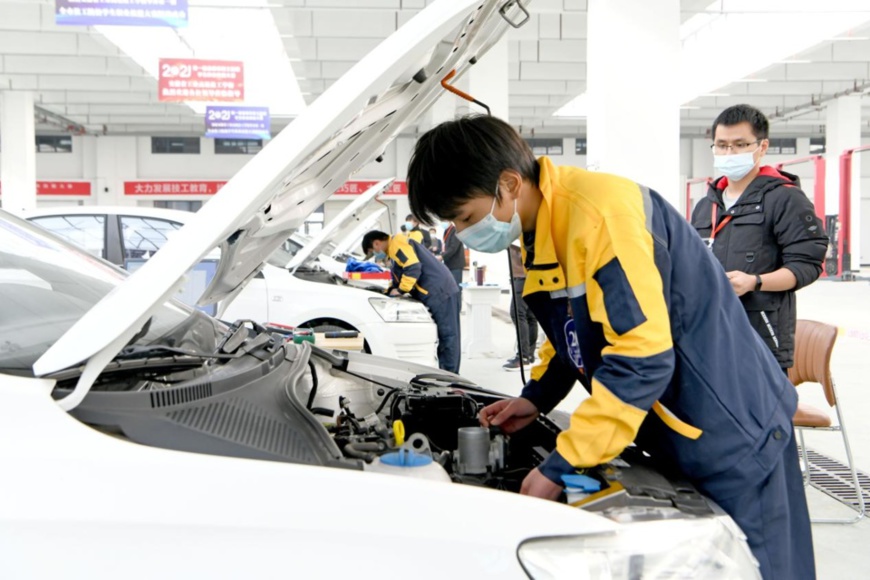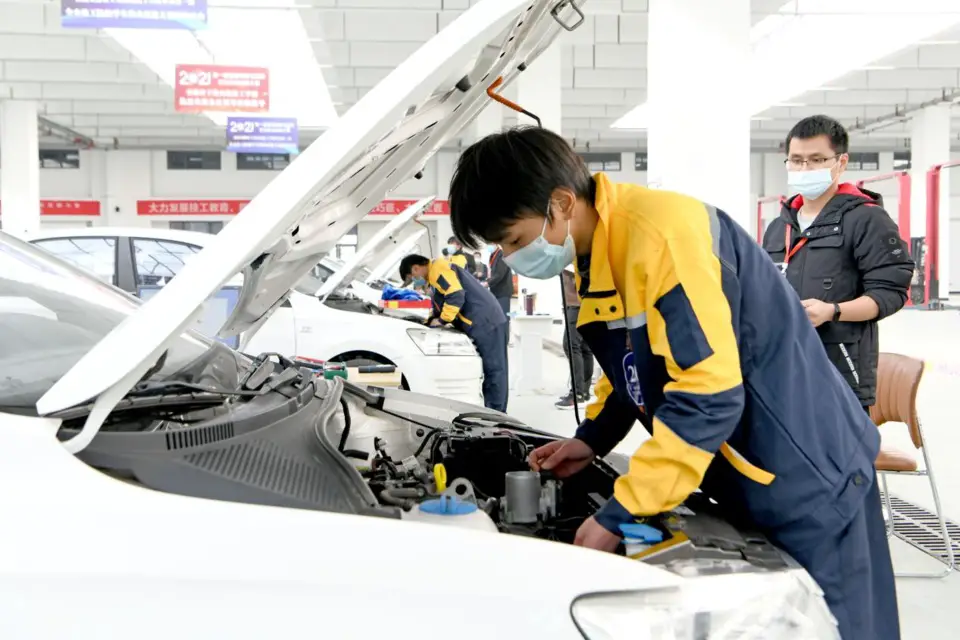By Li Xinping, People’s Daily

Photo taken on Dec. 5, 2021 shows students from vocational schools in Huainan city, east China’s Anhui province, taking part in an auto repair competition. (Photo by Chen Bin/People’s Daily Online)
China recently released a plan for vocational skills training during its 14th Five-Year Plan period (2021-2025), the first national five-year plan made by the country for boosting vocational skills training.
China’s 13th Five-Year Plan period (2016-2020) witnessed rapid development in the country’s vocational skills training. During the period, government-subsidized vocational skills training sessions trained a total of nearly 100 million people across the country, among whom more than 30 million were enterprise employees, over 40 million were rural migrant workers, and more than nine million were once-impoverished laborers.
As of the end of 2020, the country had more than 200 million skilled workers, including more than 50 million highly skilled workers.
From 2021 to 2025, more than 14 million people are expected to enter the urban labor market every year, which creates higher demands for vocational skills training.
According to the newly released special five-year plan for vocational skills training, China will subsidize vocational skills training sessions benefiting more than 75 million people, including training sessions for more than 30 million rural migrant workers, during the 14th Five-Year Plan period.
The plan also puts forward clear targets regarding the quality of training sessions. It specifies that more than 40 million trainees should obtain vocational qualification certificates or skill level certificates after the training, among whom eight million trainees should reach the skill levels of highly skilled workers such as senior mechanic, technician, and senior technician.
Considering that in order to attract more people to vocational skills training to increase the number of innovative, application-oriented, and skilled personnel, the country needs to foster a sound social atmosphere, the plan specially sets out explicit requirements regarding efforts to improve career development channels for skilled workers.
The country is trying to replace its five-grade vocational skills grading system for skilled workers, which includes junior worker, intermediate worker, senior worker, technician, and senior technician, with a new eight-grade vocational skills grading system.
China’s Ministry of Human Resources and Social Security (MOHRSS) has already promoted a new type of apprenticeship system among enterprises across the country, adding apprenticeship, before junior worker, to the job level of enterprises.
At the same time, the MOHRSS has also piloted a program to recognize and hire super-grade technicians. As grassroots organizations have innovatively created the job title of chief technician, the country’s new eight-grade vocational skills grading system is taking shape.
Efforts will be made to remove barriers blocking career change of skilled workers and their horizontal career growth, according to the plan.
In recent years, the MOHRSS has constantly rolled out policies to support highly skilled workers, including those working in such fields as engineering, agriculture, industrial art, cultural relics and museum, experimental technology, art, and sports, as well as teachers of technician schools, in taking part in professional title evaluation.
The ministry has also encouraged enterprises to enhance alignment of their employment system with the country’s professional title evaluation system.
The country will further improve the evaluation system of skilled workers. The MOHRSS plans to perfect an evaluation system of skilled workers that is oriented toward vocational skills, focuses on work performance, and emphasizes the cultivation of a spirit of craftsmanship and professional ethics.
It will promote independent vocational skills evaluation of skilled workers by enterprises across the country and encourage relevant companies to relate the evaluation results to the use and pay of employees.
So far, more than 3,100 third-party vocational skills evaluation agencies have been selected for relevant endeavors, and over 11,000 enterprises have filed with relevant authorities for carrying out independent evaluation.
In addition to encouraging enterprises to raise salary and enhance recognition of skilled workers, the MOHRSS will also hold a good number of vocational skills competitions, according to Liu Kang, director of the occupational capacity department under the MOHRSS.
Vocational skills competitions will provide opportunities for skilled workers to showcase their skills and stand out from the crowd, Liu said.
China will host the 46th WorldSkills Competition in Shanghai in October this year. The event is known as the “Olympics” for vocational skills. China has topped the world in terms of the total numbers of gold medals and medals, as well as the total scores of teams at the 44th and the 45th sessions of the WorldSkills Competition.
China’s 13th Five-Year Plan period (2016-2020) witnessed rapid development in the country’s vocational skills training. During the period, government-subsidized vocational skills training sessions trained a total of nearly 100 million people across the country, among whom more than 30 million were enterprise employees, over 40 million were rural migrant workers, and more than nine million were once-impoverished laborers.
As of the end of 2020, the country had more than 200 million skilled workers, including more than 50 million highly skilled workers.
From 2021 to 2025, more than 14 million people are expected to enter the urban labor market every year, which creates higher demands for vocational skills training.
According to the newly released special five-year plan for vocational skills training, China will subsidize vocational skills training sessions benefiting more than 75 million people, including training sessions for more than 30 million rural migrant workers, during the 14th Five-Year Plan period.
The plan also puts forward clear targets regarding the quality of training sessions. It specifies that more than 40 million trainees should obtain vocational qualification certificates or skill level certificates after the training, among whom eight million trainees should reach the skill levels of highly skilled workers such as senior mechanic, technician, and senior technician.
Considering that in order to attract more people to vocational skills training to increase the number of innovative, application-oriented, and skilled personnel, the country needs to foster a sound social atmosphere, the plan specially sets out explicit requirements regarding efforts to improve career development channels for skilled workers.
The country is trying to replace its five-grade vocational skills grading system for skilled workers, which includes junior worker, intermediate worker, senior worker, technician, and senior technician, with a new eight-grade vocational skills grading system.
China’s Ministry of Human Resources and Social Security (MOHRSS) has already promoted a new type of apprenticeship system among enterprises across the country, adding apprenticeship, before junior worker, to the job level of enterprises.
At the same time, the MOHRSS has also piloted a program to recognize and hire super-grade technicians. As grassroots organizations have innovatively created the job title of chief technician, the country’s new eight-grade vocational skills grading system is taking shape.
Efforts will be made to remove barriers blocking career change of skilled workers and their horizontal career growth, according to the plan.
In recent years, the MOHRSS has constantly rolled out policies to support highly skilled workers, including those working in such fields as engineering, agriculture, industrial art, cultural relics and museum, experimental technology, art, and sports, as well as teachers of technician schools, in taking part in professional title evaluation.
The ministry has also encouraged enterprises to enhance alignment of their employment system with the country’s professional title evaluation system.
The country will further improve the evaluation system of skilled workers. The MOHRSS plans to perfect an evaluation system of skilled workers that is oriented toward vocational skills, focuses on work performance, and emphasizes the cultivation of a spirit of craftsmanship and professional ethics.
It will promote independent vocational skills evaluation of skilled workers by enterprises across the country and encourage relevant companies to relate the evaluation results to the use and pay of employees.
So far, more than 3,100 third-party vocational skills evaluation agencies have been selected for relevant endeavors, and over 11,000 enterprises have filed with relevant authorities for carrying out independent evaluation.
In addition to encouraging enterprises to raise salary and enhance recognition of skilled workers, the MOHRSS will also hold a good number of vocational skills competitions, according to Liu Kang, director of the occupational capacity department under the MOHRSS.
Vocational skills competitions will provide opportunities for skilled workers to showcase their skills and stand out from the crowd, Liu said.
China will host the 46th WorldSkills Competition in Shanghai in October this year. The event is known as the “Olympics” for vocational skills. China has topped the world in terms of the total numbers of gold medals and medals, as well as the total scores of teams at the 44th and the 45th sessions of the WorldSkills Competition.
 Menu
Menu
 China compiles its first national five-year plan for vocational skills training
China compiles its first national five-year plan for vocational skills training
















